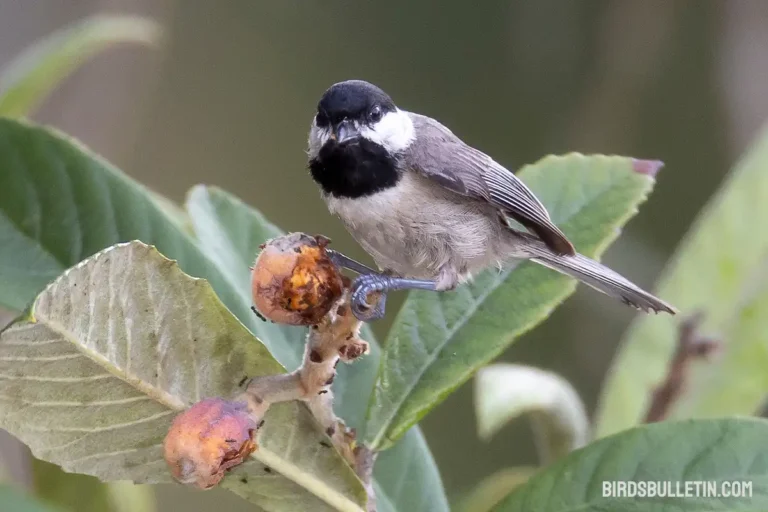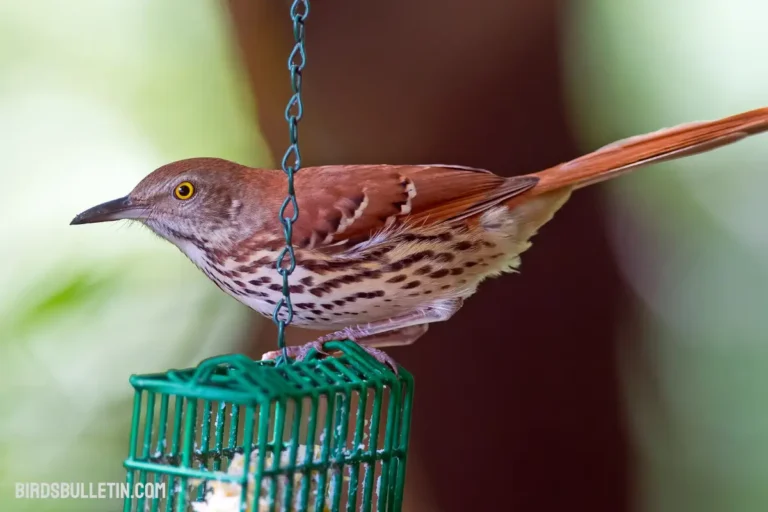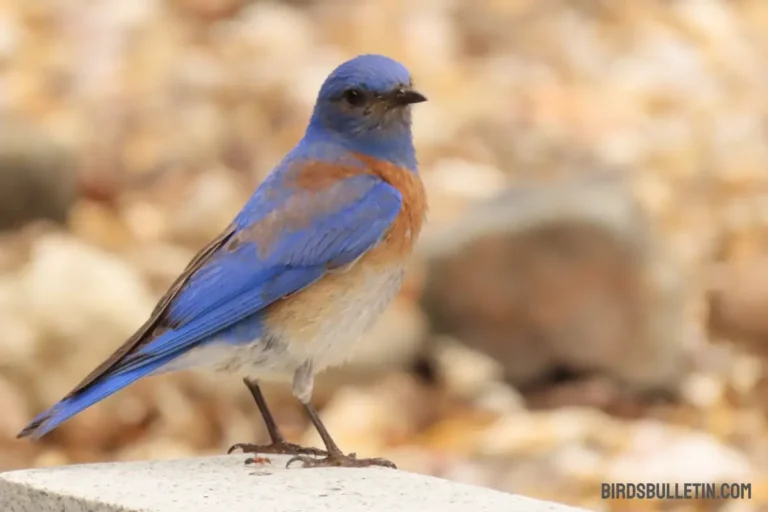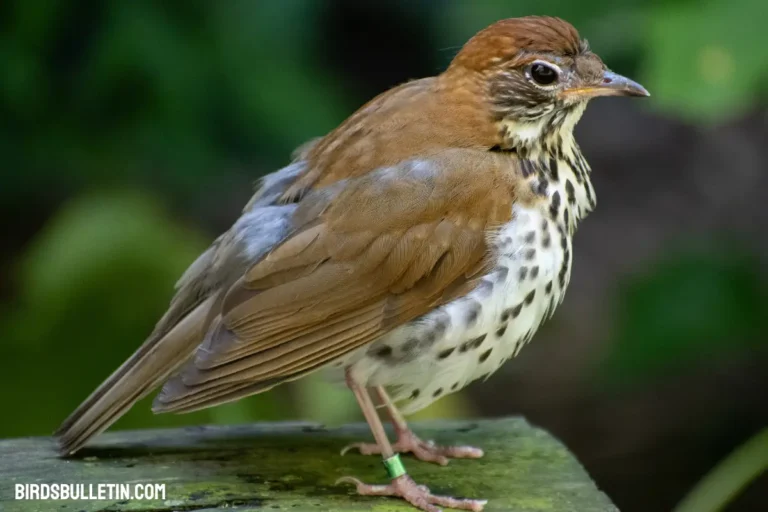Bananaquit Bird: Subspecies And More
Known locally by names like “sugar bird” and “honeycreeper,” the aptly named bananaquit reflects this small songbird’s affinity for nectar from tropical flowers and fruit.
When European colonists first observed these active foragers flitting banana plantations like busy bees, they dubbed them “bananaquits,” and the name stuck for the species’ characteristic banana-loving habits.
Want to learn more about Birds Overview
Identification
Identifying the Bananaquit involves paying attention to distinct features. Follow these steps for a successful identification:
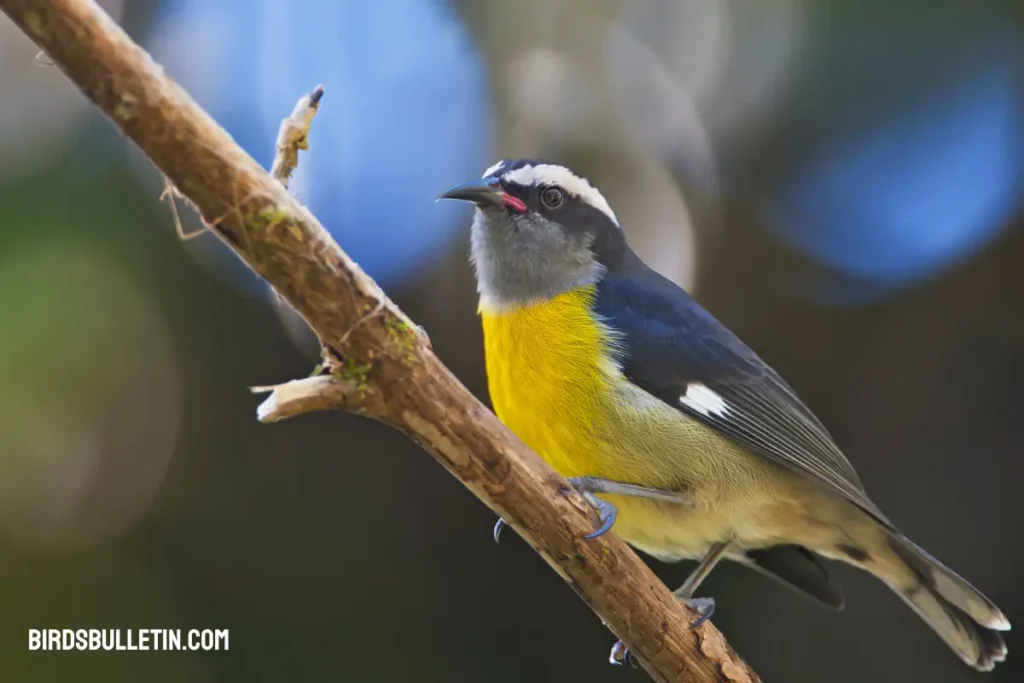
Size and Shape: The Bananaquit is a small bird, measuring around 4 inches (10 cm) in length. Observe its compact and slender body, with a straight, slightly down-curved bill.
Look for the vibrant and contrasting colors:
- Yellow: The majority of the body, especially the throat, breast, and belly.
- Black: On the head, wings, and upperparts.
- White: Visible on the lower abdomen and a distinctive stripe above the eye.
Wings and Tail: Take note of the wings, which are relatively short and rounded. The tail is often black, and its shape contributes to the overall balance of the bird’s appearance.
Bill: Observe the thin, slightly curved bill. The Bananaquit’s bill is adapted for feeding on nectar and probing into flowers.
Vocalizations: Chirps and Buzzes: Bananaquits have a variety of vocalizations, including high-pitched chirps and buzzing sounds.
Males feature a black throat, darker back, and longer tail streamers, while females show a yellow-white throat and shorter tail.
Bananaquit Profile
| Feature | Bananaquit |
|---|---|
| Scientific Name | Coereba flaveola |
| Alternative Name | Sugarbird, Yellow-breasted Bananaquit, Sikybird |
| Color | Vibrant mix of yellow, black, and white |
| Size | Small, approximately 4-5 inches (10-13 cm) |
| Wingspan | Around 6-7 inches |
| Weight | About 5.5 – 19 grams |
| Lifespan | 5-7 years, recorded 8.6 years |
| Breeding Season | Varied, influenced by geographical location |
| Lay Eggs | Typically, 2 to 3 eggs in a clutch |
| Diet and Prey | Nectar, fruit, insects, spiders |
| Threats and Predators | Threatened by habitat loss, snakes, birds of prey |
| Locations | Tropical and subtropical regions of the Americas |
State Bird And Symbol
The Bananaquit designated as the official bird of the Virgin Islands, is present across the West Indies. This bird also holds cultural significance across its Caribbean Island range. Its bright plumage and energetic personality reflect local island wildlife.
Subspecies
The Bananaquit (Coereba flaveola) exhibits a diverse range of subspecies, with 41 currently recognized.
Here is a list of these subspecies and their respective geographical distributions:
- Coereba flaveola bahamensis (Reichenbach, 1853): Bahamas
- Coereba flaveola caboti (Baird, 1873): East Yucatan Peninsula and nearby islands
- Coereba flaveola flaveola (Linnaeus, 1758): Nominate, Jamaica
- Coereba flaveola sharpei (Cory, 1886): Cayman Islands
- Coereba flaveola bananivora (Gmelin, 1789): Hispaniola and nearby islands
- Coereba flaveola nectarea Wetmore, 1929: Tortue Island
- Coereba flaveola portoricensis (Bryant, 1866): Puerto Rico
- Coereba flaveola sanctithomae (Sundevall, 1869): North Virgin Islands
- Coereba flaveola newtoni (Baird, 1873): Saint Croix (South Virgin Islands)
- Coereba flaveola bartholemica (Sparrman, 1788): North and Central Lesser Antilles
- Coereba flaveola martinicana (Reichenbach, 1853): Martinique and Saint Lucia (South Central Lesser Antilles)
- Coereba flaveola barbadensis (Baird, 1873): Barbados
- Coereba flaveola atrata (Lawrence, 1878): St. Vincent (South Lesser Antilles)
- Coereba flaveola aterrima (Lesson, 1830): Grenada and the Grenadines (South Lesser Antilles)
- Coereba flaveola uropygialis von Berlepsch, 1892: Aruba and Curaçao (Netherlands Antilles)
- Coereba flaveola tricolor (Ridgway, 1884): Providencia Island (off East Nicaragua)
- Coereba flaveola oblita Griscom, 1923: San Andrés Island (off East Nicaragua)
- Coereba flaveola mexicana (Sclater, 1857): Southeastern Mexico to Western Panama
- Coereba flaveola cerinoclunis Bangs, 1901: Pearl Islands (South of Panama)
- Coereba flaveola columbiana (Cabanis, 1866): Eastern Panama to Southwestern Colombia and Southern Venezuela
- Coereba flaveola bonairensis Voous, 1955: Bonaire Island (Netherlands Antilles)
- Coereba flaveola melanornis Phelps & Phelps, 1954: Cayo Sal Island (off Venezuela)
- Coereba flaveola lowii Cory, 1909: Los Roques Islands (off Venezuela)
- Coereba flaveola ferryi Cory, 1909: La Tortuga Island (off Venezuela)
- Coereba flaveola frailensis Phelps & Phelps, 1946: Los Frailes and Los Hermanos Islands (off Venezuela)
- Coereba flaveola laurae Lowe, 1908: Los Testigos (off Venezuela)
- Coereba flaveola luteola (Cabanis, 1850): Coastal Northern Colombia and Venezuela, Trinidad and Tobago
- Coereba flaveola obscura Cory, 1913: Northeastern Colombia and Western Venezuela
- Coereba flaveola minima (Bonaparte, 1854): Eastern Colombia and Southern Venezuela to French Guiana and North Central Brazil
- Coereba flaveola montana Lowe, 1912: Andes of Northwestern Venezuela
- Coereba flaveola caucae Chapman, 1914: Western Colombia
- Coereba flaveola gorgonae Thayer & Bangs, 1905: Gorgona Island (off Western Colombia)
- Coereba flaveola intermedia (Salvadori & Festa, 1899): Southwestern Colombia, Western Ecuador, and Northern Peru east to Southern Venezuela and Western Brazil
- Coereba flaveola bolivari Zimmer & Phelps, 1946: Eastern Venezuela
- Coereba flaveola guianensis (Cabanis, 1850): Southeastern Venezuela to Guyana
- Coereba flaveola roraimae Chapman, 1929: Tepui regions of Southeastern Venezuela, Southwestern Guyana, and Northern Brazil
- Coereba flaveola pacifica Lowe, 1912: Eastern Peru
- Coereba flaveola magnirostris (Taczanowski, 1880): Northern Peru
- Coereba flaveola dispar Zimmer, 1942: North Central Peru to Western Bolivia
- Coereba flaveola chloropyga (Cabanis, 1850): East Central Peru to Central Bolivia and east to Eastern Brazil, Northern Uruguay, Northeastern Argentina, and Paraguay
- Coereba flaveola alleni Lowe, 1912: Eastern Bolivia to Central Brazil
Nesting
Bananaquits breed across the Caribbean islands and parts of Central America during March-June, raising multiple broods.
Using spider silk and fibers, females construct tidy purse-shaped nests lined with soft plant down, placing them in trees, shrubs, and even man-made structures.
Females lay 2-4 eggs that hatch after 14 days. Both parents feed chicks incubated for another 16 days until fledging, followed by 3-4 weeks of post-fledging parental care as the young birds become independent.
Habits
he bananaquit (Coereba flaveola) is a small passerine bird found in the Americas. Here are some habits and characteristics associated with bananaquits:
Diet: Bananaquits are primarily nectarivorous, meaning they feed on nectar from flowers. They use their specialized, curved bills to extract nectar from flowers. In addition to nectar, they also consume fruits and insects.
Active Feeders: Bananaquits are known for their active and agile feeding habits. They can be seen flitting from flower to flower or exploring vegetation in search of food. Their rapid wing beats and quick movements make them efficient foragers.
Adaptability: These birds are highly adaptable and can be found in various habitats, including gardens, forests, and urban areas. They are often seen in flowering trees and shrubs.
Molting: Bananaquits undergo molting, during which they shed and replace feathers. Molting helps them maintain healthy plumage for efficient flight and thermoregulation.
Range and Distribution: Bananaquits are found in a wide range of locations, from the southern United States through Central and South America and the Caribbean islands.
Population
The population of mature Bananaquit birds ranges from 5 million to 50 million individuals. Abundant and widespread, global breeding populations likely exceed several million adults.
Partners in Flight estimates multi-million and increasing populations for the Caribbean. Maintained habitat access supports stable numbers, offsetting isolated declines.
Migration
As permanent island and mainland residents, bananaquits inhabit the same tropical territories year-round without migrating seasonally. Altitude shifts allow adaptation to regional conditions.
However, the Puerto Rican subspecies travels up to 200 km overwater among inland forests and offshore cays.
Behavior
Active and social, bananaquits forage in small flocks of 6-12 birds, communicating constantly with buzzing and chipping calls. They probe blossoms using a specialized tongue to soak up nectar. Quick flights carry them between plants with hummingbird-like dexterity.
Compared to similar sugarbird species, bananaquits cover more open habitats at quicker paces thanks to energetic dispositions. They interact regularly with other small island species while feeding.
Interhuman Connection
Colorful and charismatic, the bananaquit contributes special bonds with human communities through:
- Cultural symbols in island legends and songs
- Inspiration for product names, businesses, and artwork
- Component of tropical island biodiversity and ecotourism
- Key pollinators supporting fruit crops
- Education subject in ornithology and ecology
Conservation Status
As thriving generalists, bananaquits maintain a conservation status of Least Concern. No major threats impact populations, though habitat loss reduces densities regionally. Sustainable agriculture and urban greenspaces supplement natural areas to promote continued success.
Legal Protections
The bananaquit receives basic protections under the Migratory Bird Act in the U.S. and Wildlife Protection Acts through parts of its island range.
However, as resilient urban-adapted birds, more specific protective measures remain unnecessary over most of their geography.
Frequently Asked Questions
01. What is their lifespan in the wild?
Average lifespans range around 10 years, with late-season hurricanes sometimes reducing lengths. The banded record reached 13 years and 5 months old.
02. How many eggs do bananaquits lay per year?
Highly prolific, a single pair can produce up to 8 broods per year at 2-4 eggs per clutch. This allows robust reproductive success and densities even with high fledgling mortality rates common to small songbirds.
03. What is the typical diet of Bananaquits?
Bananaquits primarily feed on nectar, supplemented by fruits, insects, and spiders.
04. Where are Bananaquits commonly found?
Bananaquits inhabit tropical and subtropical regions of the Americas, from Mexico to Argentina, in diverse habitats.
05. How do Bananaquits build their nests?
Bananaquits construct cup-shaped nests using materials like plant fibers, leaves, and spider silk.
06. Are Bananaquits migratory birds?
While some populations are resident year-round, others may exhibit seasonal movements in search of food sources.
Final Word
Capable urbanists yet integral forest partners, effervescent bananaquits exemplify adaptable tropical birdlife, shuttling essential nutrients and pollen while charming birdwatchers and agriculturists through the islands they call home.
Safeguarding the flowering trees and shrubs that sustain their energetic lifestyles allows these captivating songsters to persist as icons of Caribbean ecosystems and culture.
References
- Del Hoyo, J., Elliott, A., Sargatal, J., Christie, D.A. & de Juana, E. (eds.). (2020). Handbook of the Birds of the World Alive. Lynx Edicions, Barcelona.
- Lefebvre G., Poulin B., McNeil R. (1992). Abundance, feeding behavior, and body condition of Nearctic warblers wintering in Venezuelan mangroves. The Wilson Bulletin 104:400–412.
- BirdLife International 2017. Coereba flaveola. The IUCN Red List of Threatened Species 2017: e.T22721603A118330501.


